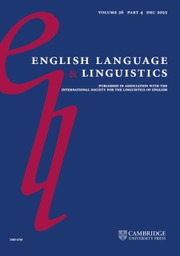Article contents
Variable assimilation of English word-final /n/: electropalatographic evidence
Published online by Cambridge University Press: 17 August 2020
Abstract
The phonetic realization of the English word-final alveolar nasal /n/ is known to be highly variable. Previous articulatory work has reported both gradient and categorical nasal place assimilation including considerable between-speaker differences. This work, however, has largely focused on a small subset of place contexts (namely, preceding velar /k, ɡ/) in a limited number of English varieties. The present article uses electropalatography to study the articulatory realization of /n/ in a wider range of phonetic contexts and read texts as produced by three speakers of Canadian English. The results reveal considerable inter- and intra-speaker differences in the rates of assimilation. Consistent with previous work, we observed a high degree of variation, both gradient and categorical, before velars. Substantial rates of assimilation were also observed before labials, where the process is unexpected from the point of view of gestural phonology but predicted by traditional phonological analyses. The variation in the place and stricture of /n/ before coronals was more limited and typically gradient. Finally, some differences were observed across the text conditions, with more assimilation occurring in carrier sentences than in the read passage and, to a more limited extent, in function than in content words.
Information
- Type
- Research Article
- Information
- Copyright
- Copyright © The Author(s), 2020. Published by Cambridge University Press
Footnotes
We wish to acknowledge helpful comments and suggestions provided by two anonymous reviewers and the editor Patrick Honeybone, the assistance of our study participants, funding from the University of Toronto Advancing Teaching and Learning in Arts and Science (ATLAS) program, and the Social Sciences & Humanities Research Council of Canada (Insight Grant #435-2015-2013 to Alexei Kochetov), as well as the assistance of Katherine Sung and Na-Young Ryu with data annotation.
References
- 2
- Cited by


